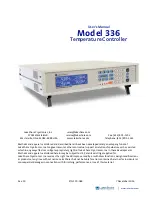
Watlow PM LEGACY™ Limit Controller
•
85
•
Chapter 8 Features
Saving and Restoring Settings
Recording setup and operations parameter settings for future reference is very important. If you unin-
tentionally change these, you will need to program the correct settings back into the controller to re-
turn the equipment to operational condition.
After you program the controller and verify proper operation, select Save Settings As
Usr.s
(Setup
Page, Global Menu) to save the settings into either of two files (
sEt1
or
sEt2
) in the control memory.
Note:
Saving the settings overwrites any previously saved collection of settings. Be sure to document all
the controller settings.
If the settings in the controller are altered a user can return the controller to one of three settings. If
previously saved,
sEt1
or
sEt2
can be restored as well as the factory
fCty
settings. Navigate to the
Setup Page, Global Menu to find the Restore
USr.r
prompt. A digital input or the Function Key can al-
so be configured to restore parameters.
Note:
When restoring factory defaults, I/O assemblies for Modbus, DeviceNet, Profibus and Ethernet along
with the zone address will be overwritten when restoring factory defaults.
Programming the Home Page
Watlow’s patented user-defined menu system improves operational efficiency. The user-defined Home
Page provides you with a shortcut to monitor or change the parameter values that you use most of-
ten.
You can create your own Home Page with as many as 20 of the active parameters. When a parameter
normally located in the Setup Page or Operations Page is placed in the Home Page, it is accessible
through both. If you change a parameter in the Home Page, it is automatically changed in its original
page. If you change a parameter in its original page it is automatically changed in the Home Page.
The default parameters will automatically appear in the Home Page.
Change the list of parameters in the Home Page from the Custom Menu
CUSt
(Factory Page)
Inputs
Calibration Offset
Calibration offset allows a device to compensate for an inaccurate sensor, lead resistance or other
factors that affect the input value. A positive offset increases the input value, and a negative offset de-
creases the input value. The input offset value can be viewed or changed with Calibration Offset
i.Ca
(Operations Page, Analog Input Menu).
















































